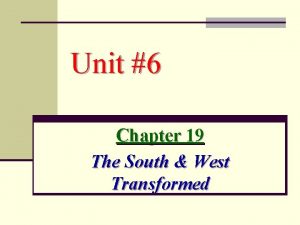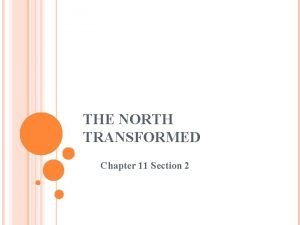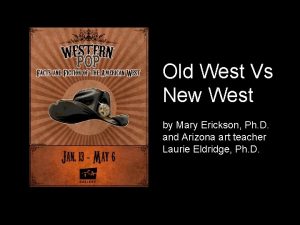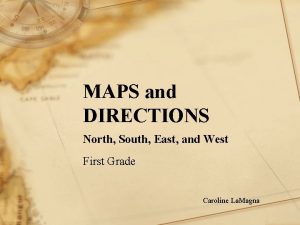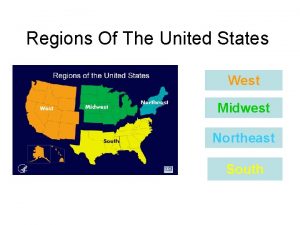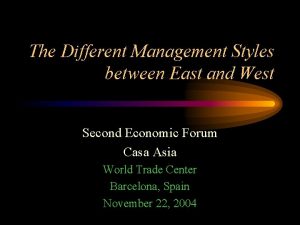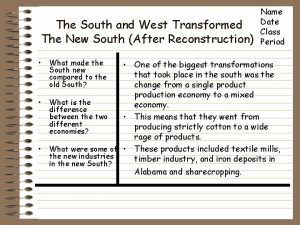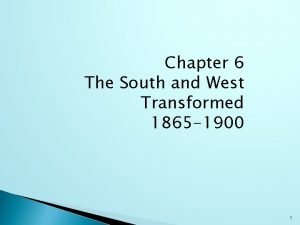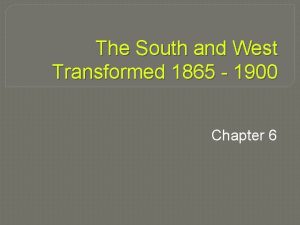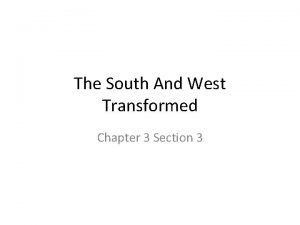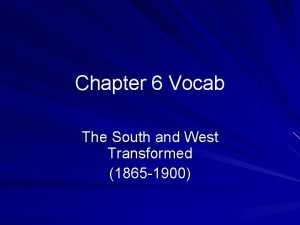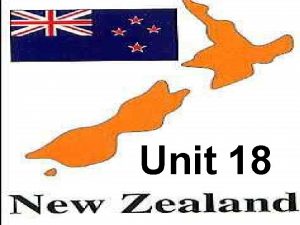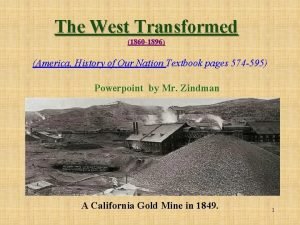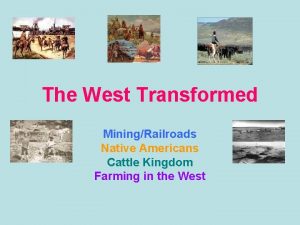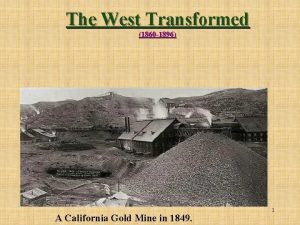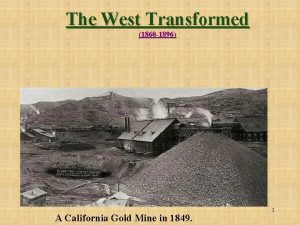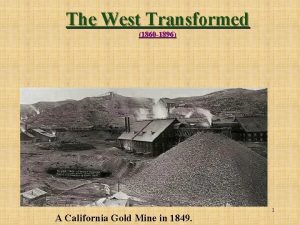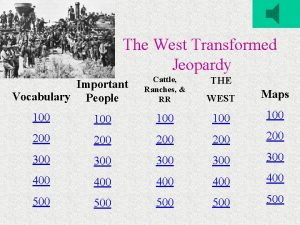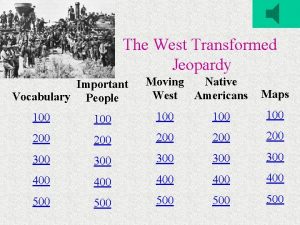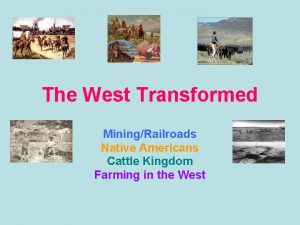Unit 6 Chapter 19 The South West Transformed
























- Slides: 24

Unit #6 Chapter 19 The South & West Transformed

APUSH Power. Point #6. 1 (Part 1 of 2) Unit #6 Chapter 15 BFW Textbook TOPIC – The South & West Transformed [1865 -1900]

I. The Impact of War

A. Concept of the New South Henry Grady § Editor of the Atlanta Constitution. Grady’s Vision § Believed that the post-Civil War South had to liberate itself from its past and create a more modern society of small farms, vibrant cities, and thriving cities. § His leadership inspired new leadership which inspired growth in industry, education, vocation, sectional peace, and racial harmony.

A. Concept of the New South The “New South” Henry Grady

B. Economic Growth of Cotton Textile Manufacturing § The southern textile industry grew (mills and workers) which increased the demand for cotton and its resurgence. Development of the Tobacco Industry § James Buchanan Duke § American Tobacco Company (monopoly – 90% of market) § The Supreme Court ruled against the company and

B. Economic Growth (Cont’d. . . ) Coal Production § Southern resource which became a boom during the era. § Birmingham became known as the “Pittsburgh of the South. ” Lumber § The demand for housing and commerce increased the demand for lumber and led to the rise of scientific forestry.

C. Agricultural in the South Limited Diversity § Cotton, sugar, rice, and tobacco growth excelled and agriculture still dominated the region. § Region was still lacking in diversity (by northern standards). § Deflationary crop prices existed. § By 1890, a majority of Southern farms were not owned by the people who worked the land.

C. Agricultural in the South (Cont’d. . . ) Features of Sharecropping § Labor of the cropper (with no materials) was given to the land owner in exchange for supplies and a share of the crop (50%). Features of Tenancy § Labor of the cropper (with materials such as a mule, tools, or credit line) was given to the land owner in exchange for supplies and a share of the crop (about 50%).

C. Agricultural in the South (Cont’d. . . ) Impact of the Crop Lien System § Small farmers were given supplies from rural merchants to work the land. § The merchants, in return, were guaranteed mortgages or “liens” on the crops. § The system (along with sharecropping and tenantfarming) perpetuated poverty in the South as farmers (both white and black) remained in a vicious cycle of indebtedness, privation, and no real means to move

D. Tenancy’s Environmental Impact Soil Depletion § Land in the South was depleted of its nutrients as crops (mainly cotton) deteriorated any future use of the land. Soil Erosion § As soil was exhausted, tenants and croppers moved on leaving behind fields of red clay. § Waterways were clogged with silt and the land became void of any use.

E. Role of the Bourbon Redeemers Nature of the Bourbons § Southern men of social deference and political elitism. § Referred to as “Redeemers” who would save the South of “Yankee” rule. Bourbon Economic Policies § Laissez-Faire (alliance with northern capitalists) in business. § Retrenchment of state government spending.

F. Role of the Democratic Party in the New South Nature of Mongrel Coalition § Southern Democratic Party consisted of Unionists, secessionists, businessmen, small farmers, planters, and some Republicans who opposed “Radical” Reconstruction. § Created racial barriers of “segregation” between whites and blacks (who did sit on state legislatures into the early 20 th century). § Redeemers laid the lasting foundations in matter of

G. Race Relations Bourbon-Black Political Compatibility § A moderate compatibility with blacks allowed as for an open and democratic South in the 1880 s and 1890 s. § Segregation did exist and would be expanded by 1900 and throughout most of the twentieth century. § The rise on equality also sparked a resurgence in violence and intimidation of many in the South determined to keep Blacks from gaining “true

G. Race Relations (Cont’d. . . ) Disfranchisement of Blacks § By 1900, there was a resurgence of racism in the South as Mississippi and other deep southern states created new laws to combat black success and equality. § Divisions were caused by Populism (third party based on a farm-based protest movement split the white vote in some states) causing blacks to be courted by various groups.

G. Race Relations (Cont’d. . . ) Spread of Segregation § Railway cars were the symbolic form of segregation. § Seven civil rights cases came before the Supreme Court in 1883 and each one supported segregation. § Separate facilities for blacks and whites became legal with the case Plessy v. Ferguson, 1896.

G. Race Relations (Cont’d. . . ) Plessy v. Ferguson, 1896 § In 1892, Homer Plessy sat in a “White Only” car and was arrested after he announced that he was oneeighth Black. § Plessy’s case eventually made it to the Supreme Court which announced that “separate, but equal” facilities did not violate the Fourteenth Amendment of “equal protection under the law. ” § The case legalized segregation in the South until

G. Race Relations (Cont’d. . . ) Plessy v. Ferguson (1896) Homer Plessy

H. Black Responses to Racism Accommodation § Southern blacks looked inward and constructed their own culture eventually creating two societies in the South. Black Culture § Churches served as a hub for black community life including political activities. § Businesses promoted a new wave of black entrepreneurs.

H. Black Responses to Racism (Cont’d. . . ) Activism of Ida B. Wells § Ida Wells was a Crusader for equal rights during the Gilded Age and early Progressive Era. § She was an editor and writer of the newspaper, Memphis Free Speech in which she condemned the mistreatment of Blacks. § Many articles focused on “lynching” in the South which brought her national fame and recognition. § Her contribution brought attention to the many issues

H. Black Responses to Racism (Cont’d. . . ) Booker T. Washington § Argued that Blacks needed to accommodate themselves during segregation by not focusing energy on overturning Jim Crow Laws or the poll tax. § Instead, Washington argued that Blacks should “pull themselves up from their own bootstraps” by building up economic resources and establish reputations as hardworking and honest. § He led the Tuskegee Institute in Alabama which

H. Black Responses to Racism (Cont’d. . . ) “ The wisest among my race understand that the agitation of questions of social equality is the extremist folly, and that the progress in the enjoyment of all the privileges that will come to us must be the result of severe and constant struggle rather than artificially forcing. . . It is important and right that all privileges of the law be ours, but it is vastly more important that we be prepared for the exercises of these privileges. ” Booker T. Washington, Atlanta Exposition address, 1895

H. Black Responses to Racism (Cont’d. . . ) William Edward Burghardt Du Bois § Civil rights pioneer who disagreed with Booker T. Washington’s willingness to accommodate Southern Whites. § Instead, he argued that Blacks should demand full and immediate equality and not limit themselves to vocational training. § W. E. B. Du Bois (a native of Massachusetts) believed that Blacks did not need to earn equality nor the right

H. Black Responses to Racism (Cont’d. . . ) Ida Wells Booker T. Washington W. E. B. Du Bois
 The south and west transformed
The south and west transformed Chapter 11 section 2 the north transformed
Chapter 11 section 2 the north transformed Winds that blow over short distances are called
Winds that blow over short distances are called West north west wind direction
West north west wind direction Noord, oost, zuid west wijzer
Noord, oost, zuid west wijzer East is east and west is west
East is east and west is west Old west vs new west
Old west vs new west Swana
Swana Maps.google.comps
Maps.google.comps Lines that run from north to south but measure is and west
Lines that run from north to south but measure is and west Alabama alaska arizona arkansas
Alabama alaska arizona arkansas Fifty united states
Fifty united states The last west and the new south
The last west and the new south Geography of sw asia color by number
Geography of sw asia color by number South west london health and care partnership
South west london health and care partnership West midwest south northeast
West midwest south northeast North south east west leadership styles
North south east west leadership styles Cathedral 50 miles southwest of paris completed in 1220
Cathedral 50 miles southwest of paris completed in 1220 North east south west
North east south west Diet ghumanhera
Diet ghumanhera North, south east west leadership styles
North, south east west leadership styles North south east west direction
North south east west direction North south east west globe
North south east west globe Richmond ymca
Richmond ymca South west doctoral training partnership
South west doctoral training partnership
